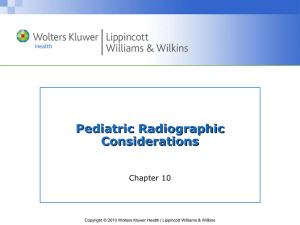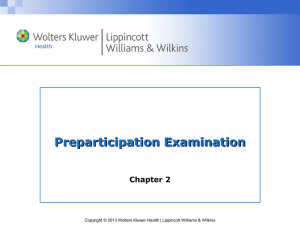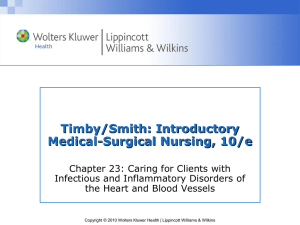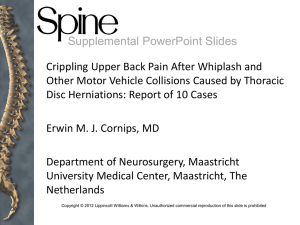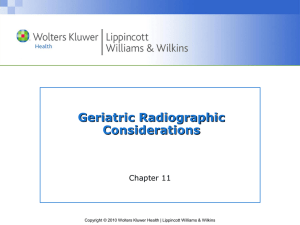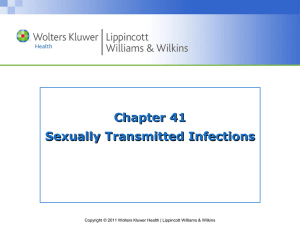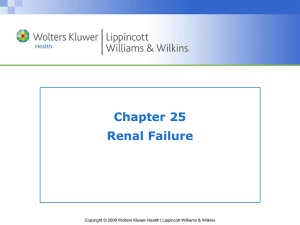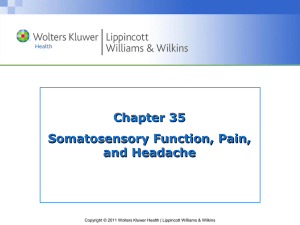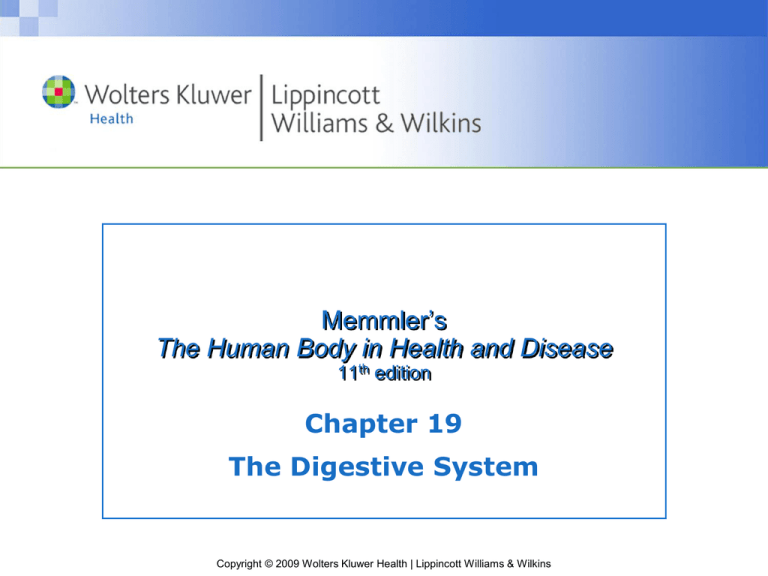
Memmler’s
The Human Body in Health and Disease
11th edition
Chapter 19
The Digestive System
Copyright © 2009 Wolters Kluwer Health | Lippincott Williams & Wilkins
Function and Design of the Digestive
System
• Chief functions
– Digestion
– Absorption
– Elimination
• Organs
– Digestive tract
– Accessory organs
Copyright © 2009 Wolters Kluwer Health | Lippincott Williams & Wilkins
The Wall of the Digestive Tract
• Mucous membrane (mucosa)
• Smooth muscle
– Digestive juice-secreting
cells
– Inner layer
– Mucus-secreting cells
(goblet cells)
– Peristalsis
– Outer layer
• Serous membrane
• Submucosa
– Connective tissue
– Epithelium
– Contains blood vessels
and nerves that help
regulate digestion
– Loose connective tissue
Copyright © 2009 Wolters Kluwer Health | Lippincott Williams & Wilkins
Wall of the digestive tract. The mucous membrane of the small intestine
shown here has numerous projections called villi.
Zooming In: What type of tissue is between the submucosa and the serous
membrane in the digestive tract wall?
Copyright © 2009 Wolters Kluwer Health | Lippincott Williams & Wilkins
The Peritoneum
Membrane that lines the abdominopelvic cavity
• Parietal peritoneum
• Visceral peritoneum
• Mesentery
• Mesocolon
• Greater omentum
• Lesser omentum
Copyright © 2009 Wolters Kluwer Health | Lippincott Williams & Wilkins
The Peritoneum (cont’d)
Peritoneal cavity: space between two layers of the membrane
• Greater peritoneal cavity: main portion, located in
abdominal cavity, extends into pelvic cavity
• Lesser peritoneal cavity: extends to the liver and the back
attachment of the diaphragm
Copyright © 2009 Wolters Kluwer Health | Lippincott Williams & Wilkins
The abdominopelvic
cavity. Subdivisions
of the peritoneum
fold over,
supporting and
separating
individual organs.
Zooming In: What
part of the
peritoneum is
around the small
intestine?
Copyright © 2009 Wolters Kluwer Health | Lippincott Williams & Wilkins
Organs of the Digestive Tract
• Alimentary tract or gastrointestinal (GI) tract
• Mouth
• Pharynx
• Esophagus
• Stomach
• Small intestine
• Large intestine
Copyright © 2009 Wolters Kluwer Health | Lippincott Williams & Wilkins
The
digestive
system.
Zooming In:
What accessory
organs of
digestion
secrete into the
mouth?
Copyright © 2009 Wolters Kluwer Health | Lippincott Williams & Wilkins
The Mouth
Also called oral cavity, processes food by
• Ingestion
• Mastication
• Mixing with saliva
• Deglutition
Copyright © 2009 Wolters Kluwer Health | Lippincott Williams & Wilkins
The Teeth
• Deciduous teeth (baby
teeth)
– 20 teeth
– Dentin
– Blood vessels
• Adult permanent teeth
– Nerves
– Gingiva
– 32 teeth
– Crown
– Incisors
– Enamel
– Cuspids (canines or
eyeteeth)
– Molars
• Structure
– Roots
– Cementum
Copyright © 2009 Wolters Kluwer Health | Lippincott Williams & Wilkins
The Pharynx
Also called the throat
• Oropharynx
• Palatine tonsils
• Nasopharynx
• Laryngeal pharynx
• Soft palate
• Uvula
• Epiglottis
Copyright © 2009 Wolters Kluwer Health | Lippincott Williams & Wilkins
The Esophagus
• Muscular tube
– No digestion occurs here
– Joins with stomach
• Esophageal hiatus
Copyright © 2009 Wolters Kluwer Health | Lippincott Williams & Wilkins
The Stomach – Structure
• Additional angled muscle layer
• Greater and lesser curvature
• Fundus
• Lower esophageal sphincter (LES) (cardiac sphincter)
• Pylorus
• Pyloric sphincter
• Rugae
Copyright © 2009 Wolters Kluwer Health | Lippincott Williams & Wilkins
The Stomach – Functions
• Store food and liquid
• Secrete gastric juice (hydrochloric acid and pepsin)
• Secrete mucus
• Chyme: highly acidic mixture of gastric juice and food that
leaves the stomach for the small intestine
Copyright © 2009 Wolters Kluwer Health | Lippincott Williams & Wilkins
Longitudinal
section of the
stomach. The
stomach’s interior
is visible, along
with a portion of
the esophagus and
the duodenum.
Zooming In: What
additional muscle
layer is in the wall
of the stomach
that is not found
in the rest of the
digestive tract?
Copyright © 2009 Wolters Kluwer Health | Lippincott Williams & Wilkins
The Small Intestine – Structure
• Duodenum
• Jejunum
• Ileum
Copyright © 2009 Wolters Kluwer Health | Lippincott Williams & Wilkins
The Small Intestine – Function
• Secrete mucus
• Secrete enzymes
• Absorb digested food
– Villi
– Microvilli
– Blood vessels
– Specialized lymphatic capillaries (lacteals)
Copyright © 2009 Wolters Kluwer Health | Lippincott Williams & Wilkins
The small and large intestines.
Zooming In: What part of the small intestine joins the cecum?
Copyright © 2009 Wolters Kluwer Health | Lippincott Williams & Wilkins
The Large Intestine — Structure
• Cecum
• Ileocecal valve
• Vermiform appendix
• Colon
– Ascending
– Transverse
– Descending
– Sigmoid
• Rectum
• Anal canal
• Anus
Copyright © 2009 Wolters Kluwer Health | Lippincott Williams & Wilkins
The Large Intestine – Function
• Secrete mucus
• Reabsorb some water
• Form feces (stool)
• Defecation
Copyright © 2009 Wolters Kluwer Health | Lippincott Williams & Wilkins
The Accessory Organs
Release secretions through ducts into digestive tract
• Salivary glands to mouth
• All other organs to duodenum
Copyright © 2009 Wolters Kluwer Health | Lippincott Williams & Wilkins
Accessory
organs of
digestion.
Zooming In:
Into what
part of the
intestine do
these
accessory
organs
secrete?
Copyright © 2009 Wolters Kluwer Health | Lippincott Williams & Wilkins
The Salivary Glands
• Functions of saliva
– Moistens food
– Facilitates mastication and deglutition
– Helps keep teeth and mouth clean
• Production of saliva
– Parotid glands
– Submandibular (submaxillary) glands
– Sublingual glands
Copyright © 2009 Wolters Kluwer Health | Lippincott Williams & Wilkins
The Liver – Structure
• Right, left lobes
• Portal vein
• Hepatic artery
Copyright © 2009 Wolters Kluwer Health | Lippincott Williams & Wilkins
The Liver – Function
• Manufacture bile
• Store glycogen, convert to glucose
• Modify fats
• Store vitamins, iron
• Form blood plasma proteins
• Destroy old red blood cells
• Synthesize urea
• Detoxify harmful substances
Copyright © 2009 Wolters Kluwer Health | Lippincott Williams & Wilkins
The Gallbladder
Bile
• Flows from liver through cystic duct
• Is stored in gallbladder
• Flows through cystic duct and common bile duct to
duodenum when needed
Copyright © 2009 Wolters Kluwer Health | Lippincott Williams & Wilkins
The Pancreas
• Releases enzymes that digest fats, proteins,
carbohydrates, and nucleic acids
• Produces alkaline (basic) fluid to neutralize acidic chyme
in small intestine
• Produces insulin and glucagon to regulate sugar
metabolism
Copyright © 2009 Wolters Kluwer Health | Lippincott Williams & Wilkins
Enzymes and the Digestive Process
Enzymes
• Speed up rate of chemical reactions
• Are not changed or used up in reactions
• Are proteins
• Are highly specific in their actions
Copyright © 2009 Wolters Kluwer Health | Lippincott Williams & Wilkins
The Role of Water
Process of digestion technically hydrolysis (split by water)
Water is used to
• Produce digestive juices
• Dilute food
• Aid chemical process of digestion
• Added to nutrient molecules as they are split by enzymes
Copyright © 2009 Wolters Kluwer Health | Lippincott Williams & Wilkins
Digestion, Step-by-Step
• Mouth
–
Chews food, mixes with saliva
–
Some starches changed to sugars
• Stomach
–
Secretes hydrochloric acid, enzymes
–
Secretes mucus
–
Forms chyme
–
Begins digestion of proteins (with pepsin)
• Small intestine
–
Mixes chyme with bile
–
Receives pancreatic juice enzymes
–
Produces enzymes
–
Emulsifies fats
Copyright © 2009 Wolters Kluwer Health | Lippincott Williams & Wilkins
Absorption
• Villi in mucosa of small intestine
– Arteriole and venule bridged with capillaries
• Capillaries absorb
– Simple sugars
– Small proteins
– Amino acids
– Simple fatty acids
– Water
• Portal system transports nutrients to liver
Copyright © 2009 Wolters Kluwer Health | Lippincott Williams & Wilkins
Absorption of Fats
• Lacteals absorb fat
• Fat/lymph mixture (chyle) drains from small intestine
• Chyle merges with lymphatic circulation, enters blood in
veins near heart
• Liver further processes absorbed fats
Copyright © 2009 Wolters Kluwer Health | Lippincott Williams & Wilkins
Absorption of Vitamins and Minerals
When vitamins and minerals are
• Dissolved in water
– Absorbed directly into blood
• Incorporated in fats
– Absorbed with fats
• Produced by bacterial action
– Absorbed in large intestine
Copyright © 2009 Wolters Kluwer Health | Lippincott Williams & Wilkins
Control of Digestion
• Nervous
– Parasympathetic stimulation increases activity
– Sympathetic stimulation decreases activity
• Hormonal
– Digestive organs produce hormones
• Gastrin
• Gastric-inhibitory peptide (GIP)
• Secretin
• Cholecystokinin
Copyright © 2009 Wolters Kluwer Health | Lippincott Williams & Wilkins
Hunger and Appetite
• Hunger
– Hypothalamic centers regulate
– Blood nutrient levels stimulate
– Satisfied by adequate meal
• Appetite
– No relationship to need for food
– May not be satisfied by adequate meal
– Leptin; hormone produced in adipose tissue; involved in
weight regulation
Copyright © 2009 Wolters Kluwer Health | Lippincott Williams & Wilkins
Eating Disorders
• Anorexia
– Chronic loss of appetite
– Possible emotional, social factors
• Anorexia nervosa
– Psychological disorder
– Bulimia (binge-purge syndrome)
Copyright © 2009 Wolters Kluwer Health | Lippincott Williams & Wilkins
Disorders of the Digestive System
Sources of digestive problems
• Mechanical
• Nervous
• Chemical
• Hormonal
Copyright © 2009 Wolters Kluwer Health | Lippincott Williams & Wilkins
Peritonitis
Infection of the peritoneum following infection of
an organ covered by peritoneum
• Localized
• Generalized
Copyright © 2009 Wolters Kluwer Health | Lippincott Williams & Wilkins
Diseases of the Mouth and Teeth
• Dental caries
• Gingivitis
• Periodontitis
• Vincent disease
• Leukoplakia
Copyright © 2009 Wolters Kluwer Health | Lippincott Williams & Wilkins
Disorders of the Esophagus and Stomach
• Acid reflux
• Varicose veins of the esophagus
• Hiatal hernia
• Heartburn
• Chronic reflux or gastroesophageal reflux disease (GERD)
• Nausea
• Vomiting (emesis)
• Gastritis
• Flatulence
• Stomach cancer
• Peptic ulcer
• Pyloric stenosis
Copyright © 2009 Wolters Kluwer Health | Lippincott Williams & Wilkins
Intestinal Disorders
• Appendicitis
• Constipation
• Inflammatory bowel disease
(IBD)
• Intestinal obstruction
–
Crohn disease
–
Ulcerative colitis
• Irritable bowel syndrome (IBS)
• Gastroenteritis
• Diverticulitis
–
Intussusception
–
Volvulus
–
Ileus
–
Hemorrhoids
• Colon and rectum cancer
• Diarrhea
Copyright © 2009 Wolters Kluwer Health | Lippincott Williams & Wilkins
Infection of the Salivary Glands
Mumps
• Contagious viral infection of parotid salivary glands
• Possible complications
– Inflammation of testicles
– Sterility in males
• Prevented by childhood vaccine (MMR)
Copyright © 2009 Wolters Kluwer Health | Lippincott Williams & Wilkins
Cirrhosis and Other Liver Diseases
• Cirrhosis
– Active liver cells replaced by scar tissue
– Alcoholic (portal) type is most common
• Jaundice
• Hepatitis
– Liver inflammation
– Viral causes
– Known viruses that cause h. are named A through E (e.g.,
hepatitis A)
• Cancer
Copyright © 2009 Wolters Kluwer Health | Lippincott Williams & Wilkins
Gallstones
Cholelithiasis
• Most common gallbladder disease
• May remain in gallbladder or lodge in bile ducts
Copyright © 2009 Wolters Kluwer Health | Lippincott Williams & Wilkins
Pancreatitis
• Pancreatic enzymes back up into pancreas
• Can be fatal (acute pancreatitis)
Copyright © 2009 Wolters Kluwer Health | Lippincott Williams & Wilkins
Aging and the Digestive System
• Loss of appetite
• Difficulty swallowing
• Decreased digestive organ activity
• Digestive disorders
• Tumors and cancer
Copyright © 2009 Wolters Kluwer Health | Lippincott Williams & Wilkins
End of Presentation
Copyright © 2009 Wolters Kluwer Health | Lippincott Williams & Wilkins

